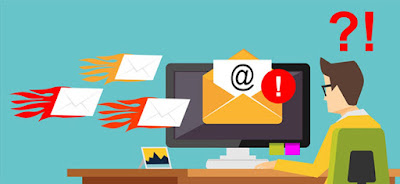WHAT IS EMAIL BOMBARDMENT?


What is a computer virus?
Viruses are computer programs that aim to alter the functioning of the computer, without the user noticing. These generally infect other system files with the intention of modifying them to intentionally destroy files or data stored on your computer. Although not all are so harmful. There are some a little more harmless that are characterized only by being annoying.
What do computer viruses do?
After entering the execution phase and releasing its payload, a computer virus initiates the attack, so it will begin to suffer negative effects on your device. As viruses hijack your code and system resources to replicate, you may also experience problems during this phase. Be on the lookout for the following effects:
· Performance read
· Damaged or missing files
· Incessant pop-ups
· Constant hard drive activity
· Crashes or crashes of programs and the operating system
· Strange things happen, such as applications that open themselves or new files that appear randomly
Aside from causing these
performance problems, viruses can also steal confidential information such as
usernames, passwords, or credit card numbers. Some viruses can send messages to
all your contacts to try to trick them into infecting them as well, which is
another method of spread.
Security measures to avoid viruses:
* Make periodic backup copies of our data.
* Avoid
downloading files from unknown places.
* Do not accept
non-original or pre-installed software without the original support.
* Protect the
disks against writing, especially those of system.
* Analyze all
the new disks that we introduce into our system with an antivirus, even empty
disks (as they may contain viruses in their boot sector).
* Periodically
analyze the hard disk, to prevent a virus from loading into memory prior to the
analysis.
* Update the
patterns of the antivirus programs every one or two months, some packages do it
automatically.
* Try to
receive the programs we need from the Internet from official sites.
* Take special
care with the files that may be included in our email, do not open files from
unknown users.
How to remove a virus:
First step: PC diagnosis.
If you suspect
or are completely sure that a virus has been hosted on your PC, because you
have noticed some symptoms in it, such as:
- Continuously
restarts
- The operating
system takes a long time to start
- If the hard
drive reports failure
- Unknown
extensions appear
The first step after detecting the virus is to check the antivirus that you currently have installed on your PC, if you do not have it, it is recommended to install one (it is better to only have one good antivirus installed since having more than one could cause conflicts on your PC).
Second step: Remove Virus.
The second step to eliminate the virus is to deactivate the system restorer, so there are some viruses that are capable of being restored immediately after each restart of the PC, for this they must right click on the properties of MY PC and check the box of disable system restore or disable system restore on all drives. After having followed the previous steps, the PC must be restarted, but now in safe mode (Pressing the upper key F8 at the moment that the operating system is raising) after this we must pass the antivirus.
Third step: Verifying the elimination of the virus.
If you carried
out all the previous steps and your PC no longer shows any symptoms that it is
still infected, from now on it is best to run the antivirus on your PC daily to
reduce the risk of another virus infecting your PC.
So, to keep our device safe and our information personal, we all should have a good antivirus in our device to keep it protected.
Comments
Post a Comment